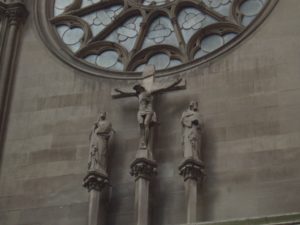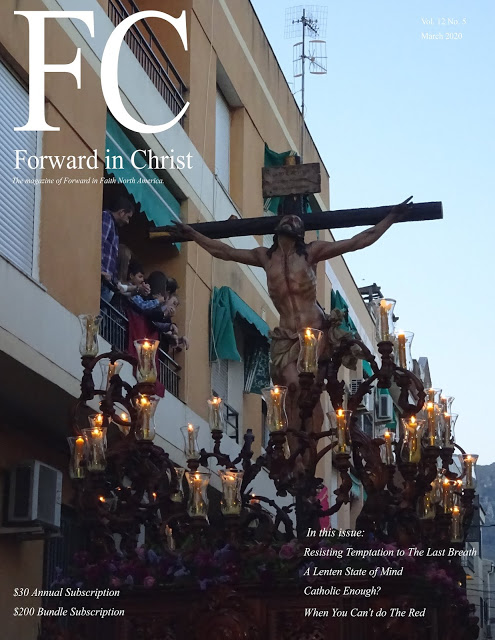An Ash Wednesday homily by the Bishop of Fort Worth, Ryan Reed.
Every Ash Wednesday, we are confronted with the fact that we are all broken people, living in broken world. The silent procession, the somber liturgy, the stark plain sanctuary, the ashes, the litany of penance: all of these remind us of the truth of our sinfulness, our brokenness, and our rebellion against God and his will for us.
In the early 20th century, an English newspaper editorial asked the question, “What’s wrong with the world?” G. K. Chesterton mailed in a two word reply: “I am.”
We begin the journey of Lent with the difficult task of looking at our own guilt and sin. The journey begins with ashes and the terrible reminder that we are fallen.
The ashes serve as a sign of remorse and repentance and take us face to face with our own brokenness. We are confronted by our own individual rebellion against God which our first parents have imparted to us. With these same ashes we are also confronted with our mortality. We are but dust and to dust we shall return. To quote the rockband Kansas, “All we are is dust in the wind”.
The journey of Lent begins with the harsh reminder that we are held captive to sin and that not one of us can escape the consequence of sin. Unless the Lord returns first, we will all die.
But the journey of Lent doesn’t end there. We will gladly cheer the arrival of our king into his city, and then, just days later, at the drop of a hat, we will shout for his death. We will stand by as he is beaten and whipped, mocked and spit upon.
We will watch as he struggles to make it to his place of execution: as he walks the way of the cross, and we will hear the distinct sound of iron striking iron as the spikes pierce his hands and his feet. We will stand in the crowd as many mock him and laugh at him. We will watch as his mother cries in pain and the most perfect thing in all creation, the man named Jesus writhes in agony. And as he breathes his last, the world will grow dark.
On the surface, this is not a journey that any of us really want to take. When we look at the cross of Christ, we see the wrath of God in all its holiness, and we see the horror and the consequences of our sin. We see the perfect justice of God meted out for our rebellion, as the blood of Jesus drips into the ground.
When we look at the cross, we see the wrath of God. But there are two sides to the cross. When we look again, we also see the love of God in all its holiness. So on the surface, we may not want to take this journey, but deep down inside, we would not miss it for anything in the world.
We start this journey on Ash Wednesday in humility and repentance, recognizing that God loves us so much that he would send his son to die for us, so that if we are willing to believe in him, we might not only be forgiven, but discover eternal life.
We put on ashes knowing that only by the grace of God have we become his children. During Lent, we journey with Jesus towards Jerusalem, as he reveals to us God’s will for his people. We rejoice at his triumphal entry and crown him with many crowns. We sit quietly in the upper room as Jesus demonstrates for us what is at the very heart of the Trinity: a perfect self-giving love which he shows us as he washes our feet. He calls us to share that same sacrificial love for each other. He then institutes a new Passover meal which will allow us to share fully in him even as he comes fully into us.
We walk with Jesus along the way of the cross, adoring him for the love he shows us and thanking him for the suffering that has removed the stain of our shame. Thanking him for taking the place that was rightfully ours.
We stand with Saint Mary and Saint John at the foot of the cross in awe that God loves us this much. And we look through the cross to a tomb where the most surprising, most amazing thing in all of creation will happen.
We stand with the women before the tomb and hear the most incredible words ever uttered by man or angel. And we come to know more fully that sin and death have been crushed and destroyed. We discover that light has overcome the darkness and that victory belongs to God. And for all of that, we will rejoice.
As the prophet Joel says, now is the time to blow the trumpet and declare a fast. Now is the time to fall on our knees in repentance because God is coming with blessings in his hand.
As we begin this journey of Lent, we look upon the cross and realize with St. Paul that now is the acceptable time, now is the day of salvation. We have an opportunity, if we use this gift of Lent, to ensure that our hearts are in the right place. To ensure, as Jesus tells us, that we are storing up treasures not here on earth, but in heaven.
We begin this journey kneeling before the altar and receiving ashes in the sign of the cross. Ashes that remind us we must repent and that apart from God we are nothing.
Ashes in the sign of the cross remind us also that we are sealed by the Holy Spirit and marked as Christ’s own forever. The sign of the cross which tells us that Jesus has conquered sin on our behalf. A cross that points beyond itself to an empty tomb in which Jesus now offers us divine life.

